Pine A64 with just a hint of Orange aftertaste!
I just received my Pine A64 or Pine64 from our good friends over at PixelDust and decided to not really do a review of it because it's way too early in the kick starter process to give a full scale review. So instead, I am just going to do an article about my impressions about this single-board computer. I should note that whenever I take a look at any piece of hardware on this site it is never a paid endorsement or advertisement from the original manufacturer and often times we'll use our own funds to purchase the hardware we write about.
Unboxing Pine A64 1gb version.
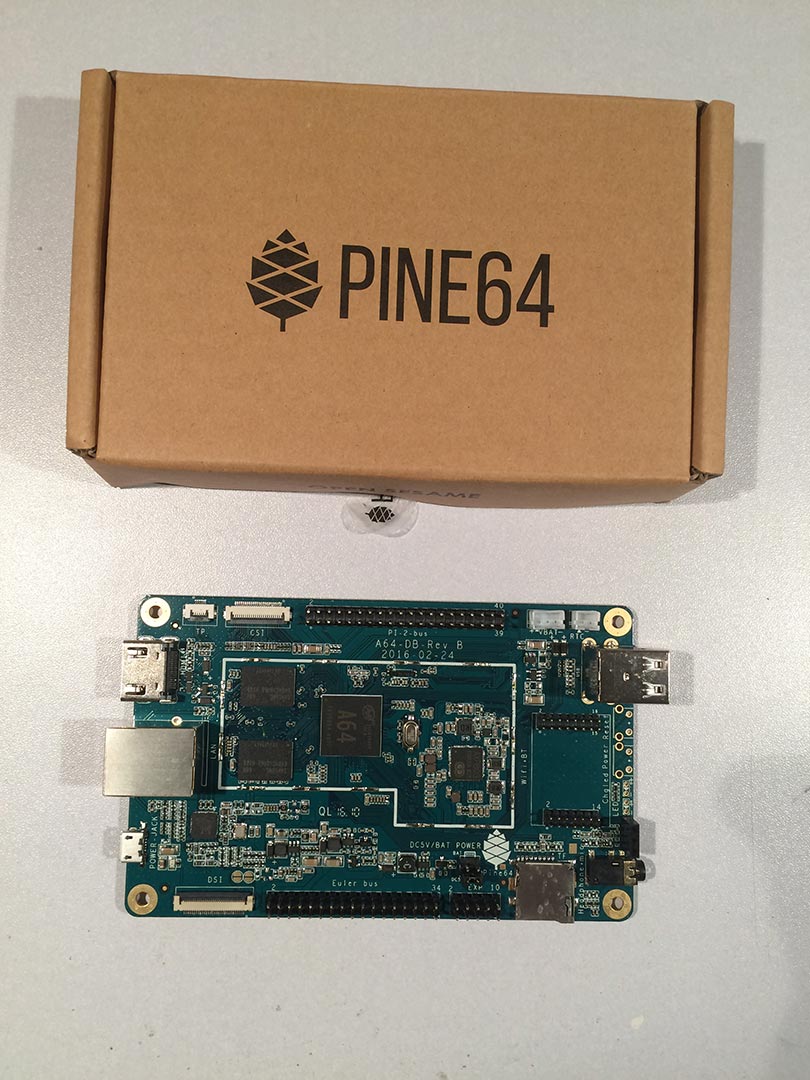 If you check pine 64's website, you'll see that there is many different variants of Pine boards out there. So I will describe the one I got.
If you check pine 64's website, you'll see that there is many different variants of Pine boards out there. So I will describe the one I got.
- Pine A64 1GB model.
- No wi-fi or bluetooth
- Gigabit network card
- $19 USD.
The reason why I got this model as I thought that was their largest Pine 64 unit. Turns out there is a 2GB version of this board as well. Oh well.
Feeling the buyer's remorse already.
After receiving this board we really wanted to get the WI-Fi/Bluetooth expansion card onto this unit because of the android OS. It turns out that you actually can't get the WI-fi/Bluetooth function alone for Pine 64. Only if we buy another board would it get that functionality. It's a shame that the Pine website does not allow the option to buy expansions for this unit even after the site touts that it's "fully expandable". You have to buy your expansions right away or else you're screwed. Although it wasn't explained all that well during the kick-starter process apparently people which got the advertised $15 pine boards cannot use the Android 5.0 operating systems on their boards due to the limited 512mb of ram. The reason for us getting this little board is for the possibility of running a blender render farm. Which does not require the unit to be in any graphical mode so long as it can run headless mode? It will eventually be a project to do with ALL of the Pi-like boards I have purchased throughout the years.
Closer look of the Pine A64
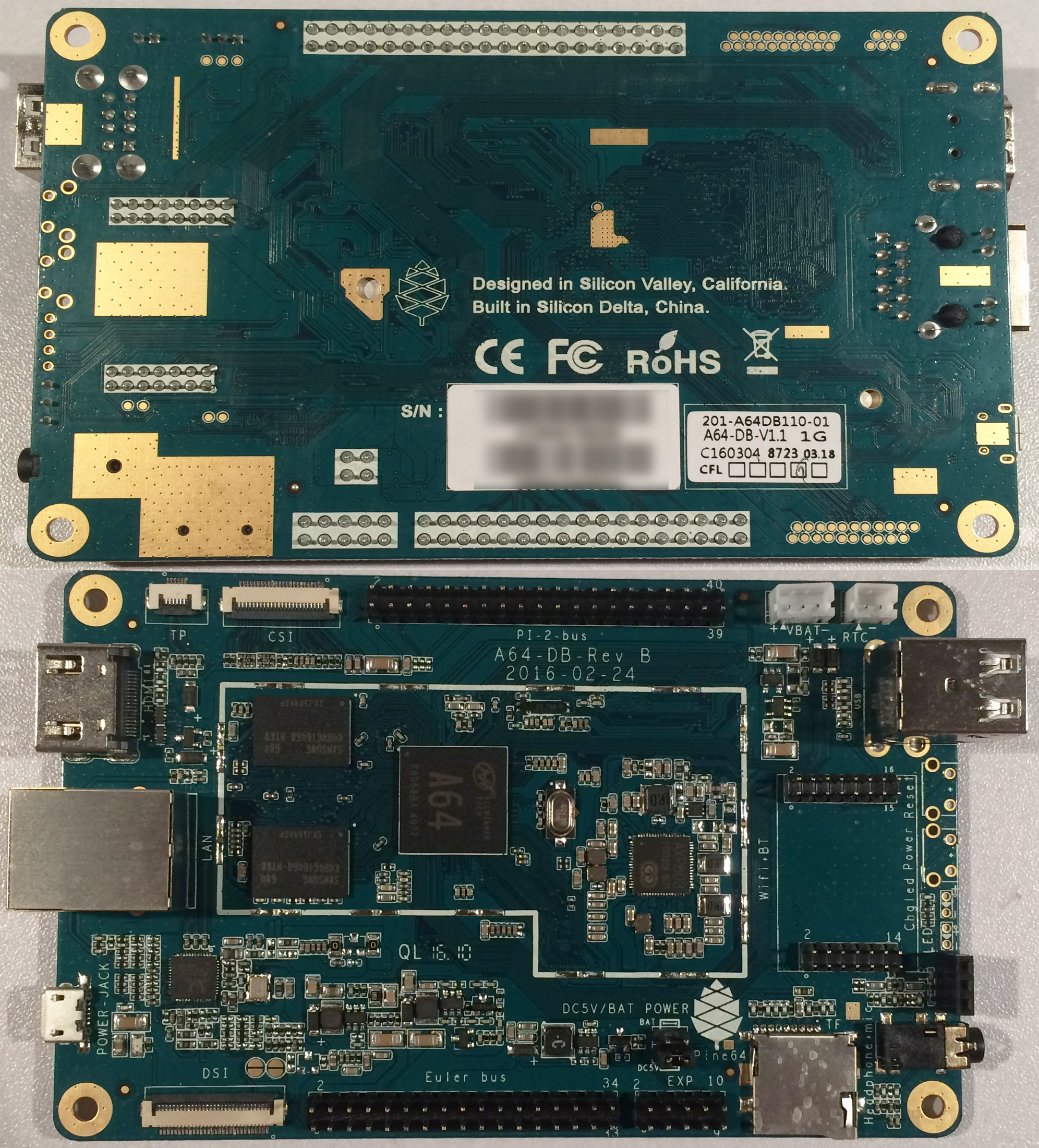 Serial numbers blurred to protect the guilty.
Serial numbers blurred to protect the guilty.
It looks like I got exactly what was described on kick-starter which the board looks very good. No bad solder connections. The only weird thing is if you look at the SD/TF slot you'll notice some sort of water/liquid marks all over the steel. It's Also visible a little bit on the RJ-45 port on this unit. When I did receive my box it was still sealed in its cardboard box and the outside contents of the box showed no signs of liquid damage.
 There have been reports that the boards arriving to kick-starters have massive warp to the boards going on due to rushed production from the Chinese plants which technically should have failed quality control. While I can see a very slight warp to my board it's nothing in comparison to some of the pictures posted out there. So I'm rather happy about the production quality of the board.
There have been reports that the boards arriving to kick-starters have massive warp to the boards going on due to rushed production from the Chinese plants which technically should have failed quality control. While I can see a very slight warp to my board it's nothing in comparison to some of the pictures posted out there. So I'm rather happy about the production quality of the board.
Some of the users are responding back that their Pine A64 boards were heavily damaged as the only thing protecting the board was the cardboard box shown above during the introduction. The mailer packet was just a soft letter packaging so the opportunity of it bouncing around during transit is incredibly high.
Raspberry Pi cock-blocking!
I'm sorry for bringing this up but I'm noticing a trend out in internet land. When this kick-starter for Pine was first introduced there was a lot of interest in this unit as Raspberry Pi (very understandably) stated that they were not going to change their hardware as it could segment and fracture their community. That Raspberry Pi wanted to make sure that regardless of what version Pi that you had that all of the educational tutorials they have been working hard to design for schools would work. Very much like the C.H.I.P. where the Raspberry Pi people of the blue came out with Pi-Zero, a $5 computer to stick it in the face of the C.H.I.P.s $7 computer. Raspberry Pi did it again towards the Pine A64 by introducing the Raspberry Pi 3 with a 64-bit Arm processor. Although truth be told at the date of this blog posting there currently isn't a 64-bit arm processor compiled Linux out there. That sure as hell didn't stop the Raspberry Pi and the Pine from proudly displaying it all over the place with the assumption that people will eventually catch up and make an OS capable of supporting it. This is to invite people to do comparisons between the Raspberry Pi gen 3 and the Pine which frankly is an unfair fight. You have a board that has years upon years of community support backing it versus a company just barely coming out of the gates from their kick-starter, of course, the Pine is going to lose any review like that. I know this is simply how "business" works even though Raspberry Pi takes the altruistic approach of saying they are doing it for "education". But it's still a dick move.
Size comparison.
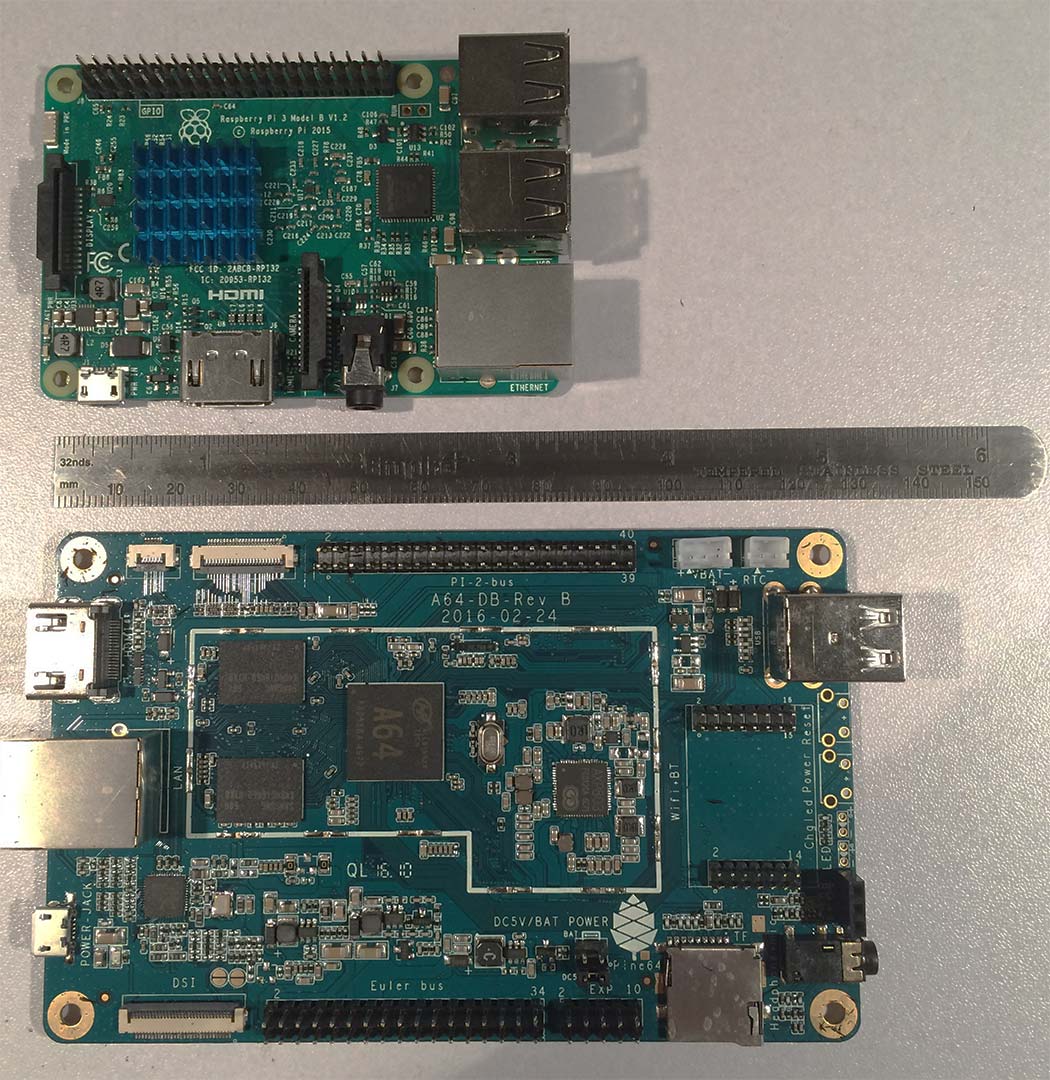 Since I just made several penis references in my last paragraph lets keep it going and talk about the size differences between the two! Yes, the Pine 64 has a larger footprint than the Raspberry Pi 3 by almost two inches. But the real question should be:
Since I just made several penis references in my last paragraph lets keep it going and talk about the size differences between the two! Yes, the Pine 64 has a larger footprint than the Raspberry Pi 3 by almost two inches. But the real question should be:
Is that necessarily a bad thing?
A lot of reviewers answer this question with a yes because they're always looking for the next smaller/cheaper/lightweight product that can do more for them. But the Pine A64 people were not going for small. They were going for speed and expansion slots. Which from a hardware engineering standpoint they have achieved this. We don't mind the board being bigger because then it could use larger heat-sinks around the processor area of the board. 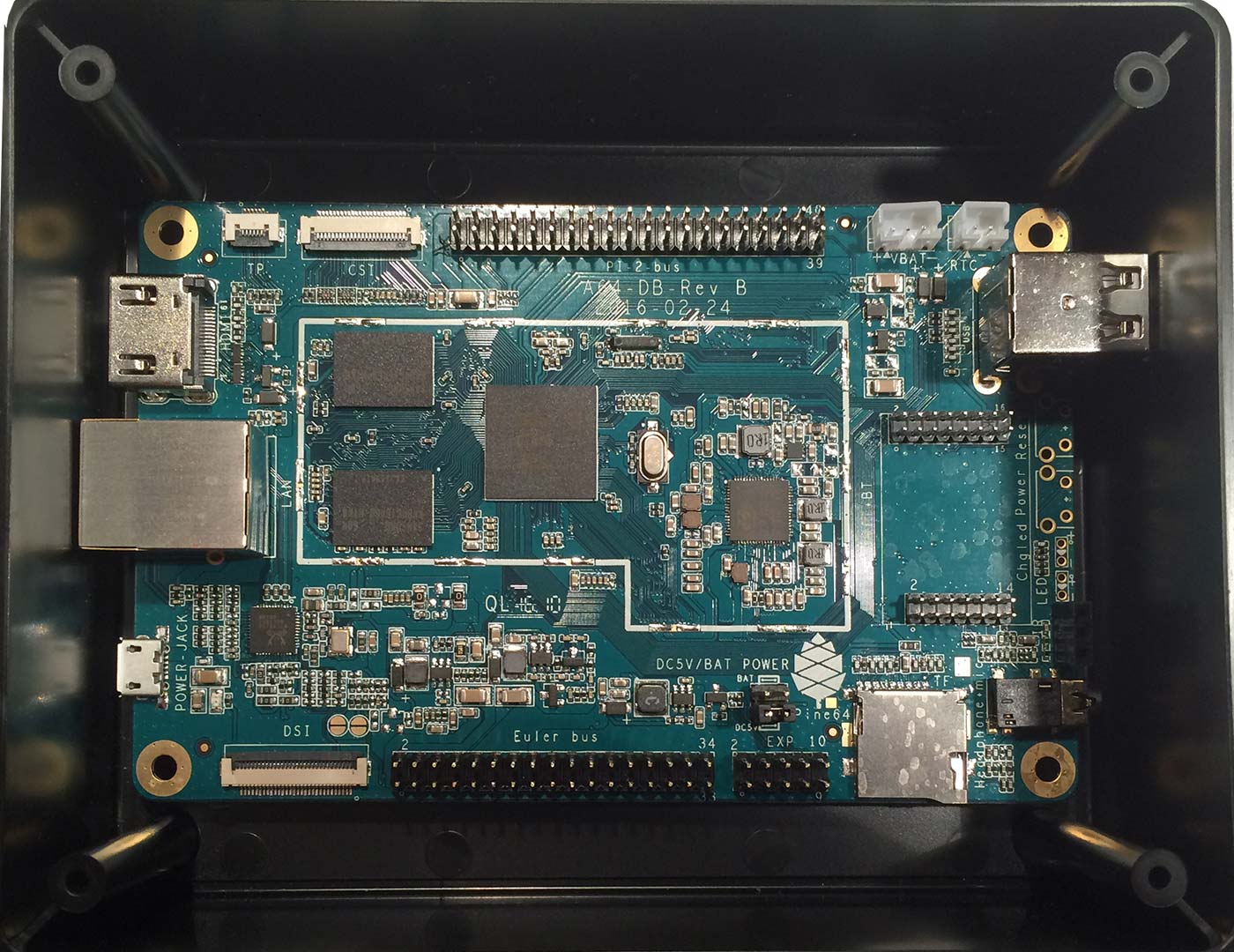 Also, because of the size of the Pine because it so happens to fit all of the plastic boxes that we have for previous projects and Pi's just about perfectly! All I really need to do is drill out some holes for all of the ports and we're done. It would have been nicer is the HDMI plug stuck out as far as the Ethernet plug so there is no giant hole for video. But those are the basic sacrifices one must take.
Also, because of the size of the Pine because it so happens to fit all of the plastic boxes that we have for previous projects and Pi's just about perfectly! All I really need to do is drill out some holes for all of the ports and we're done. It would have been nicer is the HDMI plug stuck out as far as the Ethernet plug so there is no giant hole for video. But those are the basic sacrifices one must take.
Some assembly required?
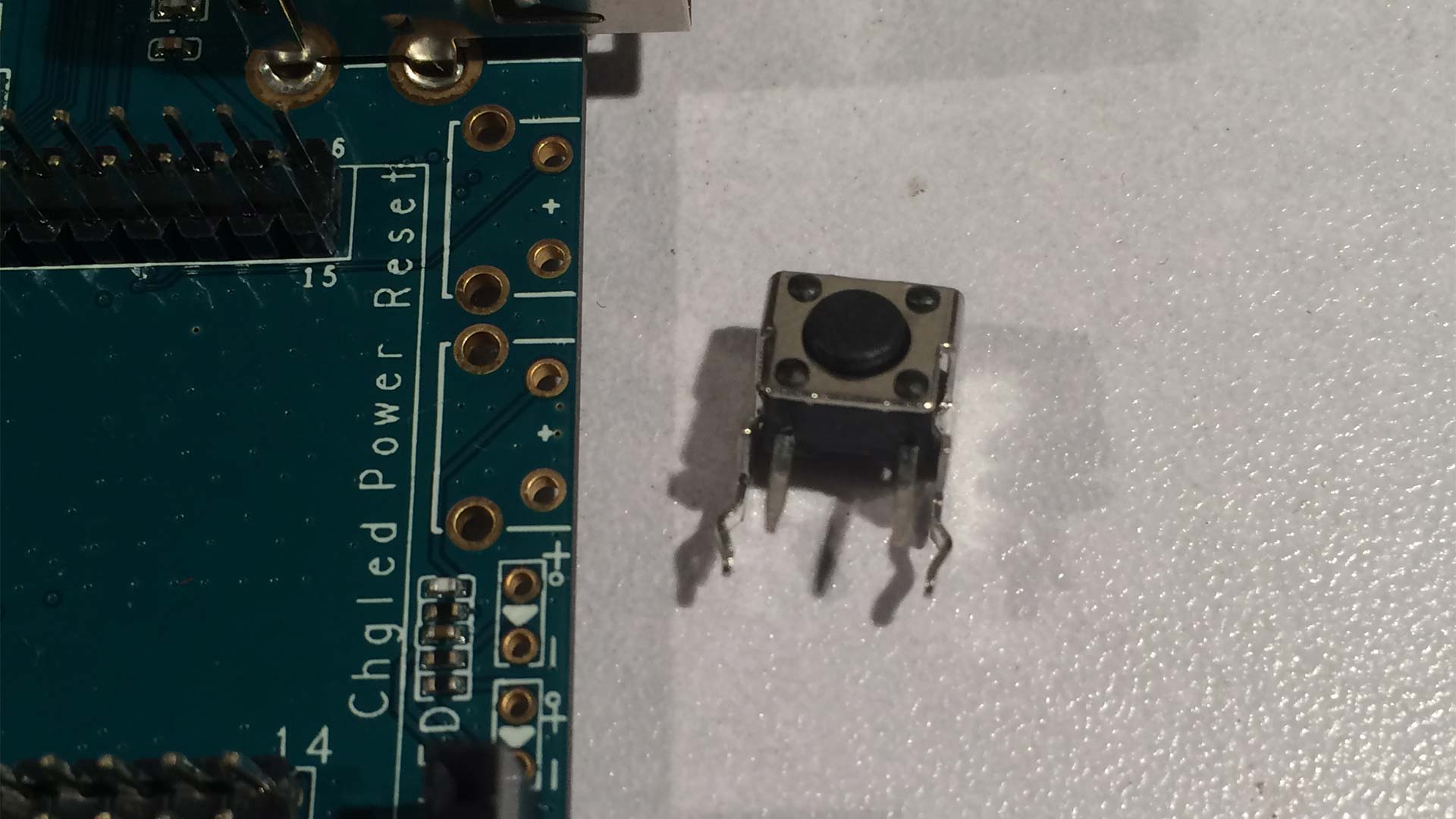 This by far has to be one of the most confusing decisions made by the Pine 64 people during the unboxing of the pine this button fell out. Was this an afterthought from the Pine 64 company that people wanted to have a power/reset button similar to the Banana Pi? If so, is the Pine 64 company aware that now they are relying on people's ability to solder this onto their boards hence voiding whatever warranty they may or may not have been on this product? If the power button was not a heavy user-requested issue then why even put this power switch into every unit is the first place and save a little money? Or was this put in there simply to screw with bloggers like us? If true then bravo Pine 64! You win! We're not sure if this is a bad or a good thing. It's just that out of all of the Pi-based boards purchased throughout the years and there has been a lot purchased here on this blog. This is the very first board that had parts falling out of the box. It's just a bizarre move.
This by far has to be one of the most confusing decisions made by the Pine 64 people during the unboxing of the pine this button fell out. Was this an afterthought from the Pine 64 company that people wanted to have a power/reset button similar to the Banana Pi? If so, is the Pine 64 company aware that now they are relying on people's ability to solder this onto their boards hence voiding whatever warranty they may or may not have been on this product? If the power button was not a heavy user-requested issue then why even put this power switch into every unit is the first place and save a little money? Or was this put in there simply to screw with bloggers like us? If true then bravo Pine 64! You win! We're not sure if this is a bad or a good thing. It's just that out of all of the Pi-based boards purchased throughout the years and there has been a lot purchased here on this blog. This is the very first board that had parts falling out of the box. It's just a bizarre move.
The website and software of Pine.
 Hardware is great and all. But it's the software which really drives the hearts of all machines. In the previous blog with Orange Pi we ripped Xulong Software for having images that don't even work with their respective Pi units. I'm happy to report that the Pine 64 company does not do this.
Hardware is great and all. But it's the software which really drives the hearts of all machines. In the previous blog with Orange Pi we ripped Xulong Software for having images that don't even work with their respective Pi units. I'm happy to report that the Pine 64 company does not do this.
Where's the image?!?
The problem with the Pine 64 company is that they don't seem to do anything! Which makes them a little worse then Xulongs Orange Pi. Looks can be deceiving on this one as Pine 64's Wiki and forum goes off to pine64.org (if you type in just pine64.org it auto forwards to pine64.com) where-as the official Pine site the Kickstarter points to goes off to pine64.com. If you do a WHOIS lookup between the two sites you'll note that they are based out of completely different locations and on top of that the official website makes absolutely no effort or reference towards the pine64.org site. The only thing that really ties the two sites together is the search engines themselves and that is mostly due to domain name association. So effectively, a Pine A64 user is to trust a wiki page of images generated by someone with no QA from the Pine 64 company itself. If the forums/wiki are the official sources of Pine A64's support and resources then it should be reflected on their website. Otherwise, who's to say that WE am the official support and resource page for pine 64 and throw out some dangerous images? Nothing.
 Almost only works when playing horse-shoe tossing and atomic warfare.
Almost only works when playing horse-shoe tossing and atomic warfare.
This clip taken off of the Pine 64 website as of 5/1/2016. Okay! Okay! This level of honesty is actually appreciated! That even though the SoC on the Pine A64 can theoretically SUPPORT 4k that there is absolutely no guarantees that this board will actually do it without frame skipping. This at least earns some brownie points over Xulong's Orange Pi which simply bullshits its way saying it's going to be a great device whenever someone actually figures out how to make the damn thing work properly. At least pine states that it will get very close and if someone comes by and makes software to achieve this %100 then awesome. If not, well, Pine 64 isn't going to worry because they did say "almost".
After all of this. We are happy to report the user (perhaps company? not sure!) images on the Wiki side of pine64.org do indeed work. And a future article will come out about my adventures in android and in Linux in due time.
The final thoughts... So far!
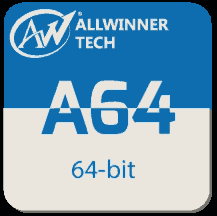 We are very grateful to live in a era where a machine with this much computing power can come at such a cheap cost. Something that would've easily taken up a few data centers in the mid-2000s is now compressed down to a low power credit card-sized board. So please do not consider the comments from this blogger about these boards as being completely ungrateful. We want companies like Pine 64 and even Xulong with their Orange Pi to actually succeed to the point where they are replacing PCs in factories and retail. Not everything needs a full-size PC in this day and age! Some would argue the notion that a Pi or in this case the Pine is up to the user to decide what they want to do with the unit. The world is your Oyster if you want a cheap startup board then boards like the Pine is there for you. But within the same token, a company has to give a starting point for the user to unlock those doors or else most would shrug and go off to your competition such as the Raspberry Pi to achieve whatever it is they wanted. Throughout this blog entry, you've noticed how comparisons are drawn between the Orange Pi and the Pine A64 during this impression. This is because both of them practically have the same hardware going for them and ultimately the same problems. They are running an Allwinner tech SoC with a Mali 400 based GPU which development for perfecting the Mali 400 within the Linux environment is going much slower than the Raspberry Pi's VC4 driver. To add insult to injury these boards require a level of power management built into the kernel or else these chips becoming burning hot even when idling (you'll find out about this when you load android onto the Pine A64) . Pine even copied the idiot red-light on the board instead of providing any status as to if the board is even attempting to boot or not. The hardware is so similar the problems mirror to that of my Orange Pi blog with SD card issues, troubleshooting board failure, bad loads, and heat problems. The real winner and the company that will go far will be the company that can master the Allwinner chipset for its users by releasing official images that will eventually become the standard for all of the other Allwinner based companies out there. Until that happens it will fall back to individual users which are good at recompiling kernels that will be the only people pushing it forward. Until then, the community will be reduced to a few people who just want to get it working for a headless environment or a simple computer. We don't feel that we're ripped off or that our friends got ripped off in getting this type of unit for us. It feels like we got exactly what we paid for which is a board and that's it. If this unit had an expansion for SATA similar to my Banana Pi we may even work really hard at making this unit my primary NAS and replace the Banana-Pi currently running in the living room.
We are very grateful to live in a era where a machine with this much computing power can come at such a cheap cost. Something that would've easily taken up a few data centers in the mid-2000s is now compressed down to a low power credit card-sized board. So please do not consider the comments from this blogger about these boards as being completely ungrateful. We want companies like Pine 64 and even Xulong with their Orange Pi to actually succeed to the point where they are replacing PCs in factories and retail. Not everything needs a full-size PC in this day and age! Some would argue the notion that a Pi or in this case the Pine is up to the user to decide what they want to do with the unit. The world is your Oyster if you want a cheap startup board then boards like the Pine is there for you. But within the same token, a company has to give a starting point for the user to unlock those doors or else most would shrug and go off to your competition such as the Raspberry Pi to achieve whatever it is they wanted. Throughout this blog entry, you've noticed how comparisons are drawn between the Orange Pi and the Pine A64 during this impression. This is because both of them practically have the same hardware going for them and ultimately the same problems. They are running an Allwinner tech SoC with a Mali 400 based GPU which development for perfecting the Mali 400 within the Linux environment is going much slower than the Raspberry Pi's VC4 driver. To add insult to injury these boards require a level of power management built into the kernel or else these chips becoming burning hot even when idling (you'll find out about this when you load android onto the Pine A64) . Pine even copied the idiot red-light on the board instead of providing any status as to if the board is even attempting to boot or not. The hardware is so similar the problems mirror to that of my Orange Pi blog with SD card issues, troubleshooting board failure, bad loads, and heat problems. The real winner and the company that will go far will be the company that can master the Allwinner chipset for its users by releasing official images that will eventually become the standard for all of the other Allwinner based companies out there. Until that happens it will fall back to individual users which are good at recompiling kernels that will be the only people pushing it forward. Until then, the community will be reduced to a few people who just want to get it working for a headless environment or a simple computer. We don't feel that we're ripped off or that our friends got ripped off in getting this type of unit for us. It feels like we got exactly what we paid for which is a board and that's it. If this unit had an expansion for SATA similar to my Banana Pi we may even work really hard at making this unit my primary NAS and replace the Banana-Pi currently running in the living room.
Drama-lama movement within Kickstarter backers.
Reading through some of the backer-only entries about some of the Kickstarter people furious about the Pine A64 to the point where death threats were getting thrown around. Also hearing users saying this board sucks because it didn't replace their Mac!! I think what happened is the Creator and CEO of Pine 64 managed to attract some apple fans due to his employment history into buying the Pine 64 and since it is a starter kind of board these end-users were simply not used to this level of user interaction. That yes, there is no real official OS, that it isn't going to cost $15-19-28 bucks and that it. That you do have to buy other things such as power supplies, SD/MMC cards, and more driving the price up. Some of them were just plain stupid screaming for their money back because their shipment was delayed a few days later than when it should be. Oh, how we forget the days of Raspberry Pi where people had to wait months later to receive their product. In the end. It's very early to tell how this is going to go down. We do hope that the Pine 64 turns their attention towards software and making their boards greater to use than any other Allwinner chipped pi on the market. If you feel that I'm being a little rough on the Pine A64 you're probably correct. This is only because the Pine A64 is not the only board on the market and they need to seriously stand out in order to win. We are fully aware of how much money is riding on the line to make their company work. Also, understand this is not "End of Line" as the company is in its infancy and could easily change things that would otherwise reverse any criticisms these blog points thus far. Just know that first impressions are everything. Make it count.

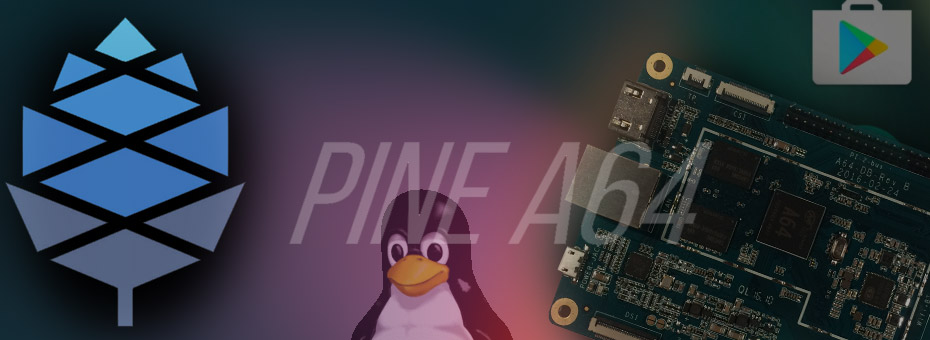
We have not been able to get any kind of reply from Pine64 using their support ticket system or by directly emailing them. We noticed on the reviews section of their facebook page that a lot of other people have been complaining about missing orders and not getting any replies either. In the Pine64 IRC they said that Pine64 is no longer using the customer support they used to and that someone named Tillim is handling support. We would not recommend Pine64 due to the companies lack of professionalism. As for the product, we no longer plan to use this brand of board and do not intend to use anything we've received.
Having owned a Raspberry Pi2 for awhile, and considering I'm not a software developer, but a hobbyist, the Pine64 was a totally disappointing waste of money. The images load, but don't really work on a 1GB board. Android is the only OS I can get to work at all, and it is much slower than even my old Galaxy S4, which I can also hook up to a keyboard / mouse / HDMI. I supported this because like you said, I wanted this company to succeed, but the board doesn't work well out of the box, and the company's response has been, in a word, pathetic. Basically at one point one of the owners said that he was having serious mental health issues because of the user response to everything surrounding the board. Delays, shipping issues, etc. This was also a lesson learned for me, as I will never support a KickStarter for hardware again unless it's something really cool and innovative. This was just another Pi, in my mind, but for the low price I thought I'd give it a shot. Next time I'll wait until the KS is over and just buy a finished product.
From the pure kickstarter standpoint it was a success for us. We did get a board in our hands. A kickstarter is only a failure if you buy something and the project decides to sit on the money for a year and then buy a house like what happened to the $100 3-d printer.:D
What happens afterwards such as how does a company deal with their success is another issue entirely. It could go overwhelmingly positive like the Raspberry Pi surpassing its original goals of just education children to being the swiss army knife of computers. Or it could die in a flaming wreck like the Ouya just after a few years with anger, silence, and ultimately a buy out. Even Pi had its problems with one of their facilities manufacturing the B+ boards installing under-rated RJ-45 jacks resulting in lots of network connection issues which could have been devastating if that was their ONLY production plant making them.
I think a kickstarter product is like drinking wine before its tame. You might get lucky and it tastes alright. But chances are, you're going to have to let it sit and mature for a little bit. So I don't blame you on waiting on your next board.:)
Thanks for the response!